Students can download 10th Science Chapter 17 Reproduction in Plants and Animals Questions and Answers, Notes, Samacheer Kalvi 10th Science Guide Pdf helps you to revise the complete Tamilnadu State Board New Syllabus, helps students complete homework assignments and to score high marks in board exams.
Tamilnadu Samacheer Kalvi 10th Science Solutions Chapter 17 Reproduction in Plants and Animals
Samacheer Kalvi 10th Science Reproduction in Plants and Animals Text Book Back Questions and Answers
I. Choose the correct answer:
Question 1.
The plant which propagates with the help of its leaves is:
(a) Onion
(b) Neem
(c) Ginger
(d) Bryophyllum
Answer:
(d) Bryophyllum
Question 2.
Asexual reproduction takes place through budding in ______.
(a) Amoeba
(b) Yeast
(c) Plasmodium
(d) Bacteria.
Answer:
(b) Yeast
![]()
Question 3.
Syngamy results in the formation of:
(a) Zoospores
(b) Conidia
(c) Zygote
(d) Chlamydospores
Answer:
(c) Zygote
Question 4.
The essential parts of a flower are ______.
(a) Calyx and Corolla
(b) Calyx and Androecium
(c) Corolla and Gynoecium
(d) Androecium and Gynoecium.
Answer:
(d) Androecium and Gynoecium.
Question 5.
Anemophilous flowers have:
(a) Sessile stigma
(b) Small smooth stigma
(c) Colored flower
(d) Large feathery stigma
Answer:
(d) Large feathery stigma
Question 6.
Male gametes in angiosperms are formed by the division of ______.
(a) Generative cell
(b) Vegetative cell
(c) Microspore mother cell
(d) Microspore.
Answer:
(a) Generative cell
Question 7.
What is true of gametes?
(a) They are diploid
(b) They give rise to gonads
(c) They produce hormones
(d) They are formed from gonads
Answer:
(d) They are formed from gonads
Question 8.
A single highly coiled tube where sperms are stored, get concentrated and mature is known as ______.
(a) Epididymis
(b) Vasa efferentia
(c) Vas deferens
(d) Seminiferous tubules.
Answer:
(d) Seminiferous tubules.
Question 9.
The large elongated cells that provide nutrition to developing sperms are:
(a) Primary germ cells
(b) Sertoli cells
(c) Leydig cells
(d) Spermatogonia
Answer:
(b) Sertoli cells
Question 10.
Estrogen is secreted by ______.
(a) Anterior pituitary
(b) Primary follicle
(c) Graafian follicle
(d) Corpus luteum.
Answer:
(b) Primary follicle
![]()
Question 11.
Which one of the following is an IUCD?
(a) Copper – T
(b) Oral pills
(c) Diaphragm
(d) Tubectomy
Answer:
(a) Copper – T
II. Fill in the blanks:
- The embryo sac in a typical dicot at the time of fertilization is ………
- After fertilization the ovary develops into ………
- Pianaria reproduces asexuallv by ………
- Fertilization is ……….. in humans.
- The implantation of the embryo occurs at about ……….. day of fertilization.
- ………. is the first secretion from the mammary gland after child birth.
- Prolactin is a hormone produced by …………
Answer:
- Double fertilization
- Fruits
- Regeneration
- Internal
- 6 to 7
- Colostrum
- Anterior pituitary
III. Match the following:
Question 1.

Answer:
A. (ii)
B. (iii)
C. (i)
Question 2.
Match the following terms with their respective meanings
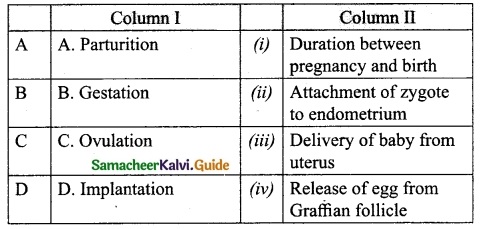
Answer:
A. (iii)
B. (i)
C. (iv)
D. (ii)
IV. State whether the following statements are True or False. Correct the false statement.
1. Stalk of the ovule is called pedicle.
2. Seeds are the product of asexual reproduction.
3. Yeast reproduces asexually by means of multiple fission.
4. The part of the pistil which serves as a receptive structure for the pollen is called as style.
5. Insect pollinated flowers are characterized by dry and smooth pollen.
6. Sex organs produce gametes which are diploid.
7. LH is secreted by the posterior pituitary.
8. Menstrual cycle ceases during pregnancy.
9. Surgical methods of contraception prevent gamete formation.
10. The increased level of oestrogen and progesterone is responsible for menstruation.
Answer:
1. False – Stalk of the ovule is called Funiculus
2. False – Seeds are the product of sexual reproduction
3. False – Budding reproduces asexually by means of multiple fission.
4. False – The part of the pistil which serves as a receptive structure or the pollen is called as stigma.
5. False – Wind pollinated flowers are characterized by dry and smooth pollen.
6. False – Sex organs produce gametes which are haploid
7. False – Anterior pituitary (LH is secreted by the Anterior pituitary)
8. True
9. True
10. True
V. Answer in a word or sentence.
Question 1.
If one pollen grain produces two male gametes, how many pollen grains are needed to fertilize 10 ovules?
Answer:
Atleast 10 pollen grains required to fertilise 10 ovules because only one male gamete is involved in the fusion of male gamete with the egg cell.
Question 2.
In which part of the flower germination of pollen grains takes place?
Answer:
Pollen grains reach the stigma and begin to germinate.
Question 3.
Name two organisms which reproduces through budding.
Answer:
Yeast and hydra reproduce through budding.
Question 4.
Mention the function of the endosperm.
Answer:
The endosperm provides food to the developing embryo.
Question 5.
Name the hormone responsible for the vigorous contractions of the uterine muscles.
Answer:
Oxytocin from the posterior pituitary stimulates the uterine contraction.
![]()
Question 6.
What is the enzyme present in the acrosome of sperm?
Answer:
Hyaluronidase is the enzyme, present in the acrosome of sperm, which helps the sperm to enter the ovum during fertilization.
Question 7.
When is World Menstrual Hygiene Day observed?
Answer:
Every year May 28th is observed as Menstrual Hygiene day to make girls and women aware of maintaining menstrual hygiene and importance of menstrual hygiene for good health.
Question 8.
What is the need for contraception?
Answer:
Contraception is used to prevent pregnancy, to check population growth.
Question 9.
Name the part of the human female reproductive system where the following occurs, (a) Fertilization (b) Implantation
Answer:
(a) Fertilization: Occurs in the oviduct of the female genital tract. It takes place usually in the ampulla of the fallopian tube.
(b) Implantation: Blastocyst reaches the uterus (uterine wall) (endometrium)
VI. Short Answer Questions
Question 1.
What will happen if you cut planaria into small fragments?
Answer:
Each fragment will develop into a new individual by a specialized mass of cell. It is called regeneration. It is the ability of the lost body parts of an individual organism to give rise to a whole new organism.
Question 2.
Why is vegetative propagation practised for growing some type of plants?
Answer:
The vegetative part of plant, root, stem, leaf or budgets detached from the parent body and grows into an independent daughter plant by mitotic division. The daughter plants are genetically similar to the parent plant.
Question 3.
How does binary fission differ from multiple fission?
Answer:

Question 4.
Define triple fusion.
Answer:
The fusion involving two polar nuclei and a sperm nucleus, that occurs in double fertilization in a seed plant and results in the formation of endosperm, is called the triple fusion.
Question 5.
Write the characteristics of insect-pollinated flowers.
Answer:
- The flowers are brightly coloured to attract insects which have smell and nectar.
- The pollen grains are larger in size, the exine is pitted, spiny, so they can be adhered firmly on the stucky stigma.
Question 6.
Name the secondary sex organs in male.
Answer:
The secondary sex organs in the male are vas deferens, Epididymis, seminal vesicle, prostate gland and penis.
![]()
Question 7.
What is colostrum? How is milk production hormonally regulated?
Answer:
The milk produced from the breast during the first 2 to 3 days after child birth is called colostrum. Milk production from alveoli of mammary glands is stimulated by prolactin secreted from the anterior pituitary.
Question 8.
How can menstrual hygiene be maintained during menstrual days?
Answer:
Maintaining menstrual hygiene is important for the overall health of women.
- Sanitary pads should be changed regularly, to avoid infections due to microbes from vagina and sweat from genitals.
- Use of warm water to clean genitals, to get rid of menstrual cramps.
- Wearing loose clothing, to ensure the airflow around the genitals, to prevent sweating.
Question 9.
How does developing embryo gets its nourishment inside the mother’s body?
Answer:
The developing embryo gets nutrition from the mother’s blood with the help of a special tissue called placenta. It is embedded in the uterine wall. This is a disc like tissue which develops between the uterine walls and embryo. It has villi of embryo side of the tissue. On the mother side are blood spaces with the villi. This gives a large surface area for oxygen and glucose to pass from the mother to the embryo.
Question 10.
Identify the parts A, B, C and D.
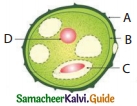
Answer:
A – Exine
B – Intine
C – Generative nucleus
D – Vegetative nucleus
Question 11.
Write the events involved in the sexual reproduction of a flowering plant.
- Discuss the first event and write the types.
- Mention the advantages and disadvantages of that event.
Answer:
- The transfer of pollen grains from the anther to the stigma of a flower is called pollination. Self – Pollination and Cross-Pollination are the two types of Pollination.
- Advantages:
- It results in fertilization, which leads to the formation of fruits and seeds.
- New varieties of plants are formed, through a new combination of genes,
- Disadvantages:
- More wastage of pollen grains.
- Pollination may fail due to the distance barrier.
- Flowers depend on external agencies for pollination.
Question 12.
Why are the human testes located outside the abdominal cavity? Name the pouch in which they are present.
Answer:
Human testes responsible for synthesis of male gametes(sperms) need slightly lower temperature than the normal body temperature for this function. Thus, they are located outside the abdominal cavity in a sac like structure called scrotum.
Question 13.
The luteal phase of the menstrual cycle is also called the secretory phase. Give reason.
Answer:
During the Luteal phase of the menstrual cycle in the uterus, the hormone progesterone is produced by the ovaries. Progesterone and estrogen are secreted by the Corpus Luteum, which develops from the Graafian follicle. So this phase of the menstrual cycle is called the secretory phase.
Question 14.
Why are family planning methods not adopted by all the people of our country?
Answer:
Family planning is a way of living that is adopted voluntary by couples on the basis of knowledge and responsible decision to promote the health and welfare of the family group and society. As it is voluntary many people are not aware of the importance of family planning.
![]()
VII. Long Answer Questions.
Question 1.
With a neat labelled diagram describe the parts of a typical angiospermic ovule.
Answer:
Structure of the Ovule : The main part of the ovule is the nucellus which is enclosed by two integuments leaving an opening called as micropyle. The ovule is attached to the ovary wall by a stalk known as funiculus. Chalaza is the basal part.
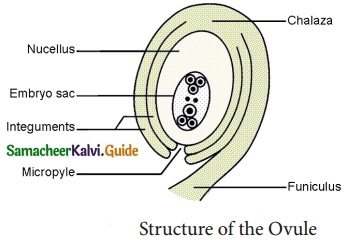
The embryo sac contains seven cells and the eighth nuclei located within thenucellus. Three cells at the micropylar end form the egg apparatus and the three cells at the chalaza end are the antipodal cells. The remaining two nuclei are called polar nuclei found in the centre. In the egg apparatus one is the egg cell (female gamete) and the remaining two cells are the synergids.
Question 2.
What are the phases of menstrual cycle? Indicate the changes in the ovary and uterus.
Answer:
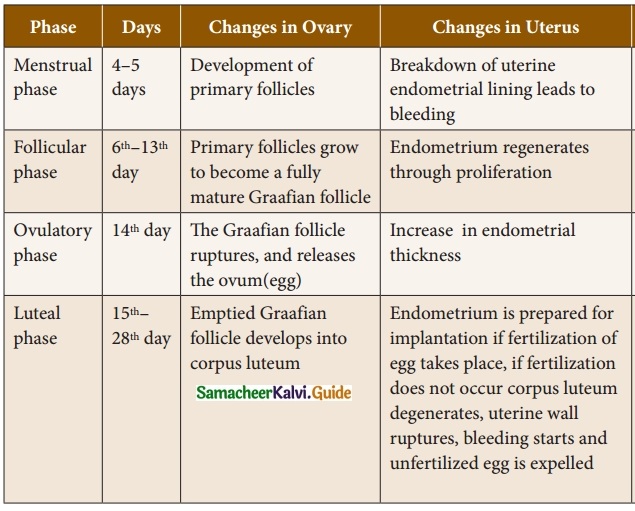
VIII. Higher Order Thinking Skills: (HOTS)
Question 1.
In angiosperms, the pollen germinates to produce a pollen tube that carries two gametes. What is the purpose of carrying two gametes when single gamete can fertilize the egg?
Answer:
One sperm fuses with the egg (syngamy) and forms a diploid zygote. The other sperm fuses with the secondary nucleus (Triple fusion) to form the primary endosperm. After triple fusion, the primary endosperm nucleus develops into an endosperm. The purpose of carrying two gametes is, endosperm provides food to the developing embryo.
Question 2.
Why menstrual cycle does not take place before puberty and during pregnancy?
Answer:
Menstruation occur when the egg is not fertilized. Every month uterus prepares itself to receive the fertilized egg to nourish the embryo, its lining becomes thick and spongy for implantation of the fertilized egg.
In case egg is not fertilized thin lining breaks and discharged out of the body through the vagina in the form of blood.
This condition will not happen before puberty and during pregnancy.
Question 3.
Read the following passage and answer the questions that follow:
Rohini and her parents were watching a television programme. An advertisement flashed on the screen which was promoting the use of sanitary napkins. Rohini’s parents suddenly changed the channel, but she objected to her parents and explained the need and importance of such advertisement.
(a) What is first menstruation called? When does it occur?
(b) List out the napkin hygiene measures taken during menstruation?
(c) Do you think that Rohini’s objection towards her parents was correct? If so, Why?
Answer:
(a) The first period or menstruation is a point in time, known as Menarche. It usually begins between 12 to 15 years of age.
(b)
- The sanitary pad and tampons should be wrapped properly and discarded because they can spread infections.
- Sanitary pad or tampon should not be flushed down the toilet.
- Napkin incinerators are to be used properly for disposal of used Napkins.
(c) No, it was not correct. The parents and teachers have to create awareness among the school girls about the use of Napkins and their proper disposal. Girls should be educated and should know the importance of such advertisement on Television.
![]()
Samacheer Kalvi 10th Science Reproduction in Plants and Animals Additional Important Questions and Answers
I. Choose the correct answer:
Question 1.
In a pollen grain the small nucleus is:
(a) Generative nucleus
(b) Tube nucleus
(c) Vegetative nucleus
(d) Pollen nucleus
Answer:
(a) Generative nucleus
Question 2.
The female part of the flower is ______.
(a) Androecium
(b) Anemophily
(c) Gynoecium
(d) Micropyle.
Answer:
(c) Gynoecium
Question 3.
Spirogyra is an:
(a) Virus
(b) Fungi
(c) Bacteria
(d) Algae
Answer:
(d) Algae
Question 4.
During pregnancy, the uterus expands, it’s normal size up to ______.
(a) 200 times
(b) 500 times
(c) 600 times
(d) 800 times.
Answer:
(b) 500 times
Question 5.
In wind pollinated flowers, the pollen grains are:
(a) sticky and powdery
(b) small and powdery
(c) dry and powdery
(d) wet and powdery
Answer:
(c) dry and powdery
Question 6.
Androecium is the part of the flower.
(a) upper
(b) male
(c) lower
(d) female
Answer:
(b) male
Question 7.
Zygote is a resulting product of:
(a) Germination
(b) Pollination
(c) Fusion of Embryosac
(d) Fertilization
Answer:
(d) Fertilization
Question 8.
Pick out the correct statement:
(a) Endosperm is a connective tissue
(b) Endosperm is a muscular tissue
(c) Endosperm is a nutritive tissue
(d) Endosperm is a nervous tissue
Answer:
(c) Endosperm is a nutritive tissue
![]()
Question 9.
The follicle that ruptures at the time of ovulation promptly fills with blood, forming:
(a) Corpus Luteum
(b) Corpus albricans
(c) Corpus Collosum
(d) Corpus Haemorrhagueim
Answer:
(a) Corpus Luteum
Question 10.
The endometrium is the lining of:
(a) bladder
(b) vagina
(c) uterus
(d) oviduct
Answer:
(c) uterus
Question 11.
Menstrual flow occurs due to lack of:
(a) Progesterone
(b) FSH
(c) Oxytocin
(d) Vasopressin
Answer:
(a) Progesterone
Question 12.
Testosterone is secreted by:
(a) Leydig cells
(b) Sertoli cells
(c) Seminiferous tubule
(d) None of these
Answer:
(d) None of these
Question 13.
In mammals, maturation of sperms take place at a temperature:
(a) Equal to that of body
(b) Higher than that of body
(c) Lower than that of body
(d) At any piece of mammalian sperm
Answer:
(c) Lower than that of body
Question 14.
If menstrual cycle is 30 days and bleeding starts on 1st day, then ovulation occur on:
(a) 14th day
(b) 18th day
(c) 30th day
(d) 16th day
Answer:
(d) 16th day
Question 15.
The symbol of family planning in India is:
(a) Square
(b) Inverted red triangle
(c) Rectangle
(d) Circle
Answer:
(b) Inverted red triangle
II. Fill in the blanks.
1. Purpose of tubectomy is to prevent ………
2. Progesterone is secreted by ………..
3. Sertoli cells are found mg in ………….
4. Hormone responsible for ovulation and development of corpus luteum is ………..
5. First menstrual cycle starts is ………..
6. The functional maturation of sperms takes place in ………..
7. Seeds develops from …………
8. In ……… buds are produced in the notches along the leaf margin.
9. Androecium is a group of …………
10. In self pollination, flowers need not to depend on ………… of pollination.
11. Pollination by wind is called ………..
12. The point of attachment of ovule to the funicle is known as …………..
13. In Angiosperm pollen tube liberate their male gametes into the …………
14. Double fertiliztaion is essential for formation of ……….
15. During spore formation a structure called ………… develops from the fungal hypha
Answer:
1. Fertilization
2. Corpus luteum
3. Seminiferous tubule
4. LH
5. Menarche
6. Epididyms
7. Ovule
8. Bryophyllum
9. Stamens
10. Agents
11. Anemophily
12. Hilum
13. Synergids
14. Endosperm
15. Sporangium
![]()
III. Match the following
Question 1.
Match the Column I with Column II.

Answer:
A. (v)
B. (i)
C. (ii)
D. (iii)
E. (iv)
Question 2.
Match the Column I with Column II
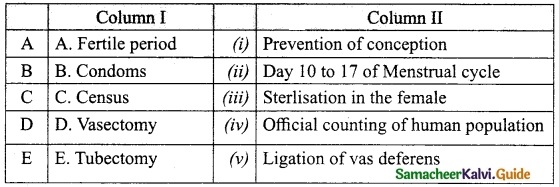
Answer:
A. (ii)
B. (i)
C. (iv)
D. (v)
E. (iii)
IV. Assertion and Reasoning:
Direction: In each of the following questions a statement of assertion (A) is given and a corresponding statement of reason (R) is given just below it. Mark the correct statement as.
Question 1.
Assertion (A): Some of the Angiospermic plants are propagated only by vegetative propagation.
Reason (R): They have lost the capacity of seed formation.
(a) If both A and R are true and R is correct explanation of A.
(b) If both A and R are true but R is not the correct explanation of A.
(c) A is true but R is false.
(d) Both A and R are false.
Answer:
(a) If both A and R are true and R is correct explanation of A.
Question 2.
Assertion (A): Double fertilization is the universal features of all plants.
Reason (R): In this fusion only male gametes and secondary nucleus takes place.
(a) If both A and R are true and R is correct explanation of A.
(b) If both A and R are true but R is not the correct explanation of A.
(c) A is true but R is false.
(d) Both A and R are false.
Answer:
(d) Both A and R are false.
Question 3.
Assertion (A): The unit of Androecium is called stamen.
Reason (R): The most important part of androecium is anther.
(a) If both A and R are true and R is correct explanation of A.
(b) If both A and R are true but R is not the correct explanation of A.
(c) A is true but R is false.
(d) Both A and R are false.
Answer:
(c) A is true but R is false.
Question 4.
Assertion (A): Anemophily includes wastage of pollen grains.
Reason (R): Anemophilous flowers are neither attractive nor fragrant.
(a) If both A and R are true and R is correct explanation of A.
(b) If both A and R are true but R is not the correct explanation of A.
(c) A is true but R is false.
(d) Both A and R are false.
Answer:
(b) If both A and R are true but R is not the correct explanation of A.
Question 5.
Assertion (A): Sexual reproduction takes place with the participation of two different type of gametes.
Reason (R): Sexual reproduction is also known as Apomixies.
(a) If both A and R are true and R is correct explanation of A.
(b) If both A and R are true but R is not the correct explanation of A.
(c) A is true but R is false.
(d) Both A and R are false.
Answer:
(c) A is true but R is false.
Question 6.
Assertion (A): In India, IUDS most widely accepted methods of contraception.
Reason (R): IUDS are injectable contraceptives, which prevent pregnancy for three months.
(a) If both A and R are true and R is correct explanation of A.
(b) If both A and R are true but R is not the correct explanation of A.
(c) A is true but R is false.
(d) Both A and R are false.
Answer:
(c) A is true but R is false.
![]()
Question 7.
Assertion (A): Over population has become a serious problem in developing countries.
Reason (R): It may exhaust natural resources, cause unemployment and lead to pollution.
(a) If both A and R are true and R is correct explanation of A.
(b) If both A and R are true but R is not the correct explanation of A.
(c) A is true but R is false.
(d) Both A and R are false.
Answer:
(a) If both A and R are true and R is correct explanation of A.
V. State whether True or false, If false write the correct statement
- Tubectomy a method of population control performed on males.
- Oral pills are very popular contraceptives among the rural women.
- The germ pore of dicot seed is known as micropyle.
- Vegetative reproduction is a kind of asexual reproduction.
- The protective wall of the pollen is intine.
Answer:
- False – Tubectomy a method of population control performed on females
- False – Oral pills are very popular contraceptives among the urban women
- True
- True
- False – The protective wall of the pollen is exine.
VI. Answer in a word or sentence:
Question 1.
Define reproduction.
Answer:
Reproduction is the process of producing offspring of their own kind.
Question 2.
Define Fertilization.
Answer:
The fusion of male gamete with female gamete to form zygote is called fertilization.
Question 3.
Where the fertilization takes place in human female?
Answer:
Fertilization in human female occurs in the oviduct of the female genetal tract. It takes place usually in the ampulla of the fallopian tube.
Question 4.
Name two types of reproduction.
Answer:
Asexual and Sexual reproduction.
Question 5.
Define Menstruation.
Answer:
Menstruation is a periodical phenomenon that continues from puberty to menopause. This will happen if the released ovum is not fertilized by the sperm.
Question 6.
Write the name of male and female reproductive part of a flower.
Answer:
Androecium and Gynoecium.
Question 7.
Define gestation period.
Answer:
Gestation is the time period during which the embryo attains its development in the uterus.
![]()
Question 8.
What is the gestation period in human?
Answer:
Normally gestation period of human last for about 280 days.
Question 9.
Write the full form of IUD and AIDS.
Answer:
IUD – Intra Uterine devices
AIDS – Acquired Immuno Deficiency Syndrome
Question 10.
What is Menopause?
Answer:
A natural decline in reproductive hormones when a woman reaches 48-50 years of age.
Question 11.
Define Pollination.
Answer:
The transfer of pollen grains from anther to stigma of a flower is called pollination.
Question 12.
What are the agents of pollination?
Answer:
Animals, Insects, Wind and Water are the agents of Pollination.
Question 13.
What is Parturition?
Answer:
Parturition is the expulsion of young one from the mother uterus at the end of gestation.
Question 14.
What is endometrium?
Answer:
The endometrium is the inner epithelial layer along with its mucous membrane of the mammalian uterus.
Question 15.
What are gonads?
Answer:
Organs of the reproductive system are gonads. Testes are male gonads and ovaries are female gonads.
Question 16.
Name two sexually transmitted disease.
Answer:
Syphilis. AIDS
Question 17.
What is Vitelline membrane?
Answer:
The membrane forming the surface layer of the ovum is called vitelline membrane.
Question 18.
Which parts of the flower transform into the seed and fruit?
Answer:
Ovule develops into seed.
Ovary develops into fruit.
Question 19.
Name two sex hormones.
Answer:
Testosterone and Progesterone
![]()
Question 20.
What is umblical cord?
Answer:
A cord containing blood vessels that connects the placenta with the foetus is called the umblical cord.
VII. Short Answer Questions
Question 1.
What is vegetative reproduction? Give an example.
Answer:
New plantlets, which are formed from the vegetative (somatic) parts of plants, such as root, stem, leaf or bud from the parent body is called vegetative reproduction, eg. In Bryophyllum, small plants grow at the leaf notches.
Question 2.
What happens when the egg is not fertilized?
Answer:
If the egg is not fertilized, corpus luteum degenerates, the egg disintegrates and the uterine lining slowly breaks, discharges as blood and mucus leading to menstrual events.
Question 3.
Explain the types of Urinary Tract Infection?
Answer:
Woman are susceptible to Urinary Tract Infection from the bacteria, that are present on skin, rectum or vagina. The types of UTI are:
- Cystitis or Bladder infection: Bacteria lodged in the urinary bladder, thrive and multiply leading to inflammation, at the age group of 20 to 50.
- Kidney Infection: The bacteria travels from the urinary bladder and upward to ureter and affect one or both the kidneys. It also infects the bloodstream and leads to serious life-threatening complications.
- Asymptomatic Bacteriuria: The bacteria present in the urinary bladder, which may not show any symptoms.
Question 4.
How does reproduction help in providing stability to population of species?
Answer:
Reproductive ensures the continuity and survival of the species. This process is to preserve individual species and it is called self perpetuation.
Question 5.
What is vegetative propagation? Write two examples where it is used.
Answer:
In vegetative propagation, new plantlets are formed from vegetative cells, buds or organs of plant. The vegetative part of plant get detached from the parent body and grow into an independent daughter plant. Root – Sweet potato, Stem – Strawberry.
Question 6.
What could be the reasons for adopting contraceptive methods?
Answer:
- To avoid frequent pregnancies, which in turn helps in population control.
- To prevent the spread of sexually transmitted diseases.
Question 7.
State in brief the function of the following organ,
(a) Ovary
(b) Fallopian tube
Answer:
(a) Ovary – Produce Oocytes (egg) for fertilization and produce hormones – Oestrogen and Progesterone.
(b) Fallopian tube – Transport the egg from the ovary to uterus.
![]()
Question 8.
Surgical methods can be used to create a block in the reproductive system for contraceptive purpose. Name such parts where block are created in
(i) Male
(ii) Female.
Answer:
(i) Male – Vasectomy – ligation of vas deferens
(ii) Female – Tubectomy – ligation of Fallopian tube
VIII. Long Answer Questions
Question 1.
List out the different methods of contraceptive. Explain any two.
Answer:
Common contraceptive methods used to prevent pregnancy are:
(i) Barrier methods
(ii) Hormonal methods
(iii) Intra-Uterine Devices (IUDs)
(iv) Surgical methods
(i) Barrier Methods : This method prevents sperms from meeting the ovum. Its entry into the female reproductive tract is prevented by barrier.
- Condom : Condom prevents deposition of sperms in the vagina. Condoms are made of thin rubber or latex sheath. Condom also protect against sexually transmitted diseases (STD) like syphilis, AIDS.
- Diaphragm (Cervical cap) : Vaginal diaphragm fitting into the vagina or a cervical cap fitting over the cervix. This prevents the entry of sperms into the uterus.
(ii) Hormonal Methods : Hormonal preparations are in the form of pills or tablets (contraceptive pills). These hormones stop (interfere with ovulation) the release of egg from the ovary.
Question 2.
Explain the structure of pollen grain with a labelled diagram.
Answer:
Pollen grains are usually spherical in shape. It has two layered wall. The hard outer layer is known as exine. It has prominent apertures called germpore. The inner thin layer is known as intine. It is a thin and continuous layer made up of cellulose and pectin. Mature pollen grains contain two cells, the vegetative and the generative cell. Vegetative cell contains a large nucleus. The generative cell divides mitotically to form two male gametes.
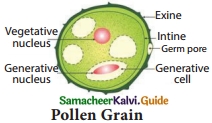
Question 3.
Write the advantages and disadvantages of self and cross pollination.
Answer:
Advantages of self-pollination:
- Self-pollination is possible in certain bisexual flowers.
- Flowers do not depend on agents for pollination.
- There is no wastage of pollen grains.
Disadvantages of self-pollination:
- The seeds are less in numbers.
- The endosperm is minute. Therefore, the seeds produce weak plants.
- New varieties of plants cannot be produced.
Advantages of cross pollination:
- The seeds produced as a result of cross pollination, develop and germinate properly and grow into better plants, i.e., cross pollination leads to the production of new varieties.
- More viable seeds are produced.
Disadvantages of cross-pollination:
- Pollination may fail due to distance barrier.
- More wastage of pollen grains.
- It may introduce some unwanted characters.
- Flowers depend on the external agencies for pollination.
Question 4.
Explain the structure of human sperm with diagram.
Answer:
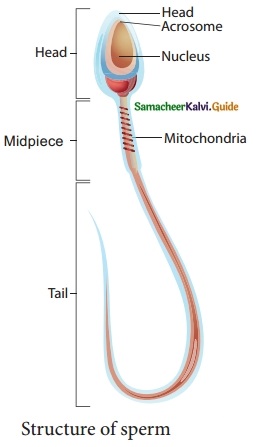
Structure of Human Sperm: The spermatozoan consists of head, a middle piece and tail. The sperm head is elongated and formed by the condensation of nucleus. The anterior portion has a cap like structure called acrosome. It contains hyaluronidase an enzyme that helps the sperm to enter the ovum during fertilization. A short neck connects the head and middle piece which comprises the centrioles. The middle piece contains the mitochondria which provides energy for the movement of tail. It brings about sperm motility which is essential for fertilization.
![]()
Question 5.
Explain the structure of ovum with diagram.
Answer:
The mature ovum or egg is spherical in shape. The ovum is almost free of yolk. It contains abundant cytoplasm and the nucleus. The ovum is surrounded by three membranes. The plasma membrane is surrounded by inner thin zona pellucida and an outer thick corona radiata. The corona radiata is formed of follicle cells. The membrane forming the surface layer of the ovum is called vitelline membrane. The fluid-filled space between zona pellucida and the surface of the egg is called perivitelline space.
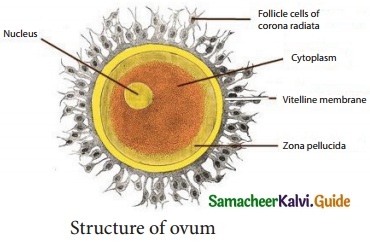
IX. Give Reason:
Question 1.
If a women is using copper – T, will it help in protecting her from sexual transmitted diseases?
Answer:
No, Copper-T does not prevent the transmission of sexually transmitted diseases. Copper-T only prevents implantation. The only safe method used to prevent the transmission of sexually transmitted diseases is the use of condoms.
Question 2.
Leaves of the Bryophyllum fallen on the ground produce new plants whereas the leaves of rose do not. Why?
Answer:
The leaves of Bryophyllum is levoad and fleshy, has notches at its margins. Buds arise from the notches, but in rose plant notches are absent.
Question 3.
The organisms formed by asexual reproduction are considered as clones. Why?
Answer:
Offspring produced by a asexual reproduction are not only identical to parents, but are also exact copies of their parent because it involves only miotic cell division.
X. Higher Order Thinking Skills (HOTS)
Question 1.
Organism A needs water to multiply and organism B needs sugar solution to multiply. Identify the organism A and B and their method of Reproduction.
Answer:
Organism A is Amoeba – which multiplies by binary fusion.
Organism B is Yeast – which needs sugar medium for budding.
Question 2.
If ovaries from a pregnant woman arc removed in 4th month of pregnancy. What will happen?
Answer:
Embryo develops normally till birth as it grows in the utreus.
![]()
Question 3.
A pregnant female not able to delivers the baby due to lack of ‘X’ hormones. Identify ‘X’ hormone. Write its function.
Answer:
The ‘X” hormone is oxytocin. It provides force to expel the baby from the uterus causing birth.